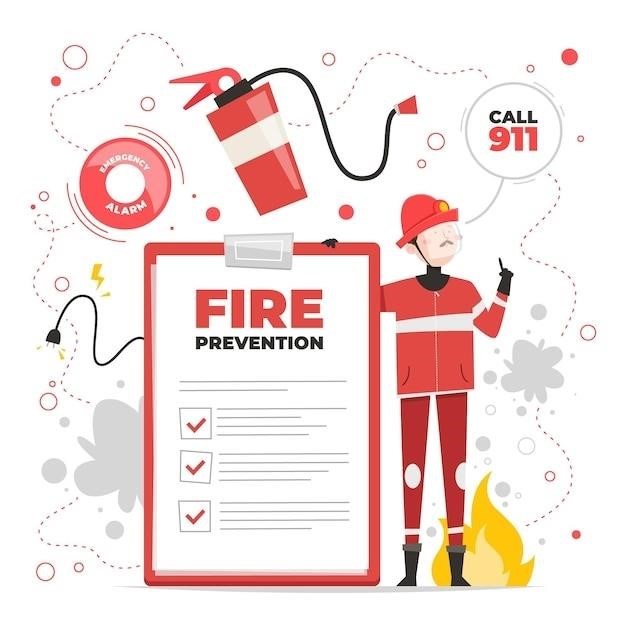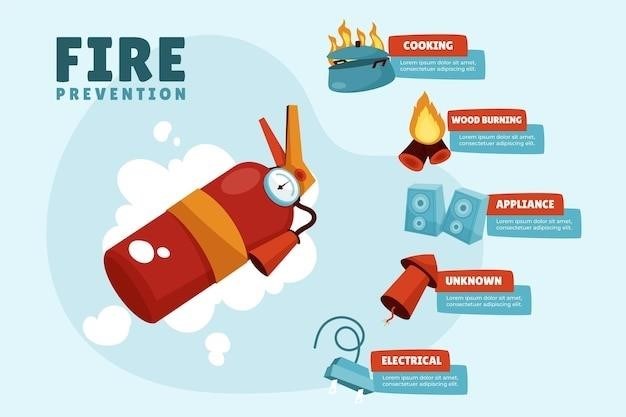Types of Fire Extinguishers
Fire extinguishers come in various types, each designed for specific fire classes. Common types include water, foam, dry chemical (ABC, BC), carbon dioxide (CO2), and wet chemical extinguishers. The choice depends on the type of fire and the material involved.
Classification of Fires
Fires are categorized into classes based on the burning material, dictating the appropriate extinguisher type. Class A fires involve ordinary combustibles like wood, paper, and cloth, requiring water-based extinguishers. Class B fires involve flammable liquids such as gasoline and oils, needing foam, dry chemical, or CO2 extinguishers. Class C fires involve energized electrical equipment; never use water; CO2 or dry chemical extinguishers are suitable. Class D fires involve combustible metals like magnesium and titanium, demanding specialized dry powder extinguishers. Class F fires involve cooking oils and fats, necessitating wet chemical extinguishers. Understanding these classifications is crucial for effective fire suppression and safety.
Types of Extinguishing Agents
Fire extinguishers utilize various extinguishing agents to suppress fires. Water is a common agent, effective for Class A fires by cooling the burning material. Foam extinguishers, often used for Class A and B fires, create a layer that smothers the flames and prevents reignition. Dry chemical agents, effective against Class A, B, and C fires, interrupt the chemical chain reaction. Carbon dioxide (CO2) extinguishers, suitable for Class B and C fires, displace oxygen, suffocating the flames. Wet chemical agents are specifically designed for Class F fires involving cooking oils and fats, creating a soapy layer to suppress the fire. The selection of the appropriate extinguishing agent is critical for successful fire control and depends entirely on the class of fire involved.
Water Extinguishers
Water extinguishers are primarily designed for Class A fires involving ordinary combustible materials like wood, paper, cloth, and some plastics. They work by cooling the burning material below its ignition temperature, effectively extinguishing the fire. Water extinguishers are generally inexpensive and readily available. However, they are not suitable for Class B (flammable liquids) or Class C (electrical) fires. Using water on flammable liquids can spread the fire, and using it on electrical fires poses a significant risk of electric shock to the user. Furthermore, water may not be effective on fires involving certain materials, such as burning oils or greases. Always ensure the fire class is correctly identified before using a water extinguisher.
Foam Extinguishers
Foam extinguishers are effective on Class A (ordinary combustibles) and Class B (flammable liquids) fires. The foam creates a blanket over the burning material, suppressing the fire by excluding oxygen and cooling the surface. This dual action makes foam extinguishers particularly useful for liquid fires, preventing reignition and reducing the spread of flames. Different types of foam exist, including protein foam, alcohol-resistant foam, and aqueous film-forming foam (AFFF), each suited to specific types of flammable liquids. However, foam extinguishers are unsuitable for Class C (electrical) fires due to the conductivity of the foam. Using a foam extinguisher on an electrical fire would pose an electrocution risk. Remember always to check the fire class symbol before deployment to ensure suitability.
Dry Chemical Extinguishers
Dry chemical extinguishers are versatile and widely used, available in various types based on their extinguishing agent and intended fire class. ABC extinguishers are multipurpose, effective against Class A (ordinary combustibles), Class B (flammable liquids), and Class C (electrical) fires. The dry chemical powder disrupts the chemical chain reaction of the fire, suppressing combustion. BC extinguishers are suitable for Class B and C fires, lacking the effectiveness on Class A fires found in ABC types. The powder’s effectiveness on electrical fires stems from its non-conductive nature, preventing further spread by interrupting the chain reaction and cooling the burning material. However, dry chemical extinguishers leave a residue that can damage sensitive equipment. After use, thorough cleaning is crucial, especially in areas with sensitive electronics. Always follow instructions and safety guidelines for proper usage.

Fire Extinguisher Selection
Selecting the right fire extinguisher is crucial for effective fire suppression. Consider the fire classes present in your environment and choose an extinguisher rated for those classes. Proper size and maintenance are also vital for safety.
Choosing the Right Extinguisher for Different Fire Classes
Fire classes are categorized by the type of fuel involved, impacting extinguisher selection. Class A fires (ordinary combustibles like wood and paper) often necessitate water-based extinguishers. Class B fires (flammable liquids like grease and gasoline) require extinguishers like foam or dry chemical types. Class C fires (energized electrical equipment) demand CO2 or dry chemical extinguishers to avoid electrical shock. Class D fires (combustible metals) need specialized dry powder extinguishers. Multi-purpose ABC extinguishers address A, B, and C fires but might not be suitable for all situations. Understanding these classifications is critical; using the wrong extinguisher can be ineffective or even dangerous. Always check the extinguisher’s label for its designated fire classes before use. Improper extinguisher selection can lead to fire spread and potentially hazardous situations. Therefore, careful consideration of the fire class is paramount for effective fire safety.
Extinguisher Size and Capacity
Selecting the appropriate fire extinguisher size is crucial for effective fire suppression. Extinguishers are rated by their capacity, typically measured in gallons or pounds, indicating the amount of extinguishing agent they contain. Larger fires demand larger extinguishers with greater capacity; a small extinguisher is insufficient for a large blaze. Consider the potential fire size and the area’s risk assessment when choosing capacity. A larger extinguisher might be necessary for areas with high fire risk or large quantities of flammable materials. However, excessively large extinguishers can be cumbersome and difficult to handle, hindering effective use. Balance the need for sufficient extinguishing agent with the practicality of handling and deploying the extinguisher. Remember that extinguisher size and capacity are interconnected with the intended application and fire class. Consult relevant safety guidelines and regulations for appropriate size recommendations based on your specific needs and risk assessment.
Maintenance and Inspection
Regular maintenance and inspection are vital for ensuring fire extinguishers remain functional and ready for use. Inspections should be conducted monthly, checking for visible damage, obstructions, and ensuring the pressure gauge indicates sufficient charge. Annual servicing by a qualified technician is crucial. This involves a thorough examination, including pressure testing, weighing, and internal inspection to identify any internal damage or leaks. Any defects should be addressed immediately. Records of inspections and servicing must be kept, documenting the date, findings, and any corrective actions taken. This detailed record-keeping is essential for compliance and demonstrates commitment to fire safety. Proper storage is also critical; extinguishers should be stored in easily accessible, clearly marked locations, protected from extreme temperatures and environmental hazards. Regular training for personnel on extinguisher use and maintenance is essential to ensure everyone understands their role in fire safety.

Using Fire Extinguishers
Effective fire extinguisher use requires training. Remember the PASS method⁚ Pull the pin, Aim at the base, Squeeze the lever, Sweep side to side. Prioritize your safety; evacuate if the fire is too large.
PASS Method
The PASS method is a crucial acronym for remembering the correct procedure when using a fire extinguisher. It stands for⁚ Pull the pin; this releases the locking mechanism, allowing you to operate the extinguisher. Aim the nozzle at the base of the fire; directing the extinguishing agent at the source is vital for effective fire suppression. Squeeze the lever; this activates the discharge mechanism, releasing the extinguishing agent. Finally, Sweep the nozzle from side to side; this ensures even distribution of the agent across the burning material, helping to extinguish the fire completely. Remember, this method is most effective for small, contained fires. Always prioritize your safety; if the fire is too large or spreading rapidly, evacuate the area immediately and call emergency services. Improper use can be dangerous, so consider professional fire safety training for comprehensive knowledge. Understanding the limitations of fire extinguishers is equally important. They are designed for initial fire response, not for tackling large, established blazes.
Safety Precautions
Before attempting to extinguish a fire, always prioritize your safety. Assess the situation carefully; if the fire is too large, spreading rapidly, or involves hazardous materials, evacuate immediately and call emergency services. Never attempt to fight a fire alone; have someone else call for help and stand ready to assist or to help you escape if necessary. Maintain a safe distance from the flames, keeping upwind to avoid smoke inhalation. Wear appropriate protective clothing if possible, including heat-resistant gloves and eye protection. Use the PASS method correctly; improper use can be dangerous. After using the extinguisher, ensure the area is adequately ventilated to remove smoke and any lingering extinguishing agent. If you have any doubts about your ability to control the fire, do not attempt to extinguish it. Your safety is paramount; it is better to err on the side of caution and evacuate than risk injury. Remember that fire extinguishers are for initial fire suppression, not for tackling large or uncontrollable fires.
Limitations of Fire Extinguishers
Fire extinguishers are valuable tools for initial fire suppression, but they have limitations. Their effectiveness depends heavily on the size and type of fire. Using the wrong type of extinguisher on a particular fire class can be ineffective or even dangerous. Extinguishers are designed for small, contained fires; they are not suitable for large, rapidly spreading fires or those involving flammable gases or electrical equipment unless specifically designed for those purposes. The range of an extinguisher is limited; if you are too far from the fire, it may be impossible to reach it. Furthermore, using a fire extinguisher requires proper training and technique; incorrect use can render the extinguisher ineffective or even lead to injury. After discharge, extinguishers require recharging or replacement, rendering them temporarily unusable; Always remember that the primary purpose of a fire extinguisher is to buy time for evacuation and professional firefighting services to arrive. Never rely solely on a fire extinguisher to handle any significant fire threat.